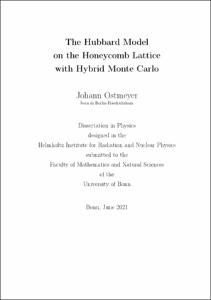The Hubbard Model on the Honeycomb Lattice with Hybrid Monte Carlo

The Hubbard Model on the Honeycomb Lattice with Hybrid Monte Carlo

| dc.contributor.advisor | Urbach, Carsten | |
| dc.contributor.author | Ostmeyer, Johann | |
| dc.date.accessioned | 2021-11-09T14:24:20Z | |
| dc.date.available | 2021-11-09T14:24:20Z | |
| dc.date.issued | 09.11.2021 | |
| dc.identifier.uri | https://hdl.handle.net/20.500.11811/9400 | |
| dc.description.abstract | We take advantage of recent improvements in the grand canonical Hybrid Monte Carlo (HMC) algorithm, to perform a precision study of the single-particle gap in the hexagonal Hubbard model, with on-site electron-electron interactions. After carefully controlled analyses of the Trotter error, the thermodynamic limit, and finite-size scaling with inverse temperature, we find a critical coupling of $U_c/kappa=num{3.835(14)}$ and the critical exponent $nu=num{1.181(43)}$ for the semimetal-antiferromagnetic Mott insulator quantum phase transition in the hexagonal Hubbard Model.
Based on these results, we provide a unified, comprehensive treatment of all operators that contribute to the anti-ferromagnetic, ferromagnetic, and charge-density-wave structure factors and order parameters of the hexagonal Hubbard Model. We expect our findings to improve the consistency of Monte Carlo determinations of critical exponents. We perform a data collapse analysis and determine the critical exponent $upbeta=num{0.898(37)}$. We consider our findings in view of the $SU(2)$ Gross-Neveu, or chiral Heisenberg, universality class. We also discuss the computational scaling of the HMC algorithm. Our methods are applicable to a wide range of lattice theories of strongly correlated electrons. The Ising model, a simple statistical model for ferromagnetism, is one such theory. There are analytic solutions for low dimensions and very efficient Monte Carlo methods, such as cluster algorithms, for simulating this model in special cases. However most approaches do not generalise to arbitrary lattices and couplings. We present a formalism that allows one to apply HMC simulations to the Ising model, demonstrating how a system with discrete degrees of freedom can be simulated with continuous variables. Because of the flexibility of HMC, our formalism is easily generalizable to arbitrary modifications of the model, creating a route to leverage advanced algorithms such as shift preconditioners and multi-level methods, developed in conjunction with HMC. We discuss the relation of a variety of different methods to determine energy levels in lattice field theory simulations: the generalised eigenvalue, the Prony, the generalised pencil of function and the Gardner methods. All three former methods can be understood as special cases of a generalised eigenvalue problem. We show analytically that the leading corrections to an energy $E_l$ in all three methods due to unresolved states decay asymptotically exponentially like $exp(-(E_{n}-E_l)t)$. Using synthetic data we show that these corrections behave as expected also in practice. We propose a novel combination of the generalised eigenvalue and the Prony method, denoted as GEVM/PGEVM, which helps to increase the energy gap $E_{n}-E_l$. We illustrate its usage and performance using lattice QCD examples. The Gardner method on the other hand is found less applicable to realistic noisy data. | en |
| dc.language.iso | eng | |
| dc.rights | In Copyright | |
| dc.rights.uri | http://rightsstatements.org/vocab/InC/1.0/ | |
| dc.subject.ddc | 530 Physik | |
| dc.title | The Hubbard Model on the Honeycomb Lattice with Hybrid Monte Carlo | |
| dc.type | Dissertation oder Habilitation | |
| dc.publisher.name | Universitäts- und Landesbibliothek Bonn | |
| dc.publisher.location | Bonn | |
| dc.rights.accessRights | openAccess | |
| dc.identifier.urn | https://nbn-resolving.org/urn:nbn:de:hbz:5-64230 | |
| ulbbn.pubtype | Erstveröffentlichung | |
| ulbbnediss.affiliation.name | Rheinische Friedrich-Wilhelms-Universität Bonn | |
| ulbbnediss.affiliation.location | Bonn | |
| ulbbnediss.thesis.level | Dissertation | |
| ulbbnediss.dissID | 6423 | |
| ulbbnediss.date.accepted | 04.11.2021 | |
| ulbbnediss.institute | Mathematisch-Naturwissenschaftliche Fakultät : Fachgruppe Physik/Astronomie / Helmholtz-Institut für Strahlen- und Kernphysik (HISKP) | |
| ulbbnediss.fakultaet | Mathematisch-Naturwissenschaftliche Fakultät | |
| dc.contributor.coReferee | Luu, Thomas | |
| ulbbnediss.contributor.orcid | https://orcid.org/0000-0001-7641-8030 | |
| ulbbnediss.contributor.gnd | 1247849163 |
Files in this item
This item appears in the following Collection(s)
-
E-Dissertationen (4337)




